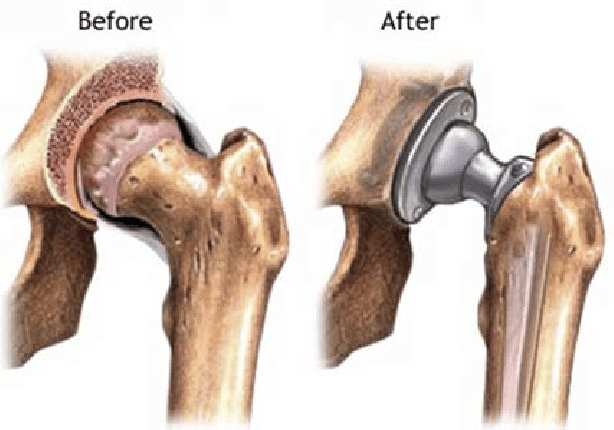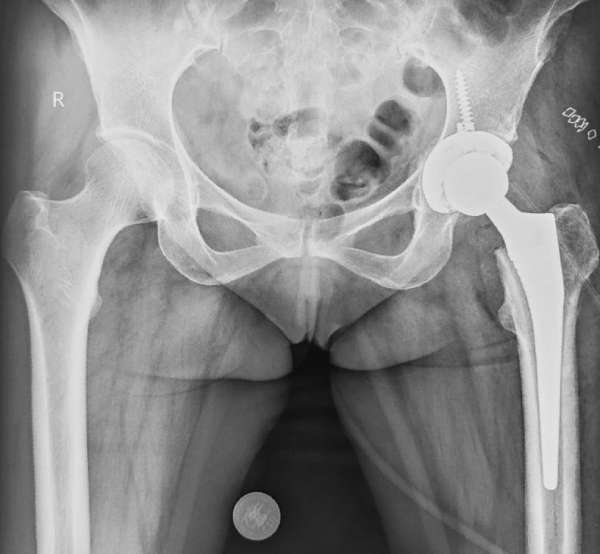Hip Replacement Surgery
What is Total Hip Replacement?
Total hip replacement is a surgical procedure where the damaged or arthritic hip joint is removed and replaced with an artificial ball-and-socket joint called a prosthesis. This hip replacement surgery helps restore mobility and reduce pain, significantly improving the patient’s quality of life. It is recommended for severe hip arthritis or injury when non-surgical treatments are no longer effective. The components include acetabular shell (socket), acetabular liner, femoral stem, and femoral head (ball). Depending upon the material of the components, various combinations can exist such as metal-on-poly, ceramic-on-poly, and ceramic-on-ceramic which describes the make of the femoral head (ball) as it articulates with the acetabular liner (socket).

What patient can expect before surgery?
- Detailed clinical examination to recognize the degenerative disease of the hip and the presence of additional pathologies if any. Functional scoring of the patient is done which is repeated after surgery at follow-up visits.
- X-ray of the hip to evaluate the condition of the bone and the joint and ascertain the extent of the disease.
- X-ray of the lumbosacral spine (lower back)
- Some patients may require an MRI of the hip to understand the disease process better. This holds for patients suffering from osteonecrosis (AVN) of the femoral head or patients with tuberculosis of the hip.
- CT scan of the hip joint may be needed in certain patients where the bone is of poor quality with resultant areas of porous bone called cysts. CT can also help in patients who have an abnormally shaped bone which can be either since birth (congenital) or secondary to some disease.
- Preoperative physiotherapy assessment to assess the muscle strength and range of motion and to start “Pre-hab” exercises
- Anesthesia checkup to recognize potential medical issues that can affect the peri-operative course
- Additional investigations like blood tests, chest Xray, electrocardiogram (ECG), or any other test as determined by the anesthetist / physician as being essential for surgery

Why is it Done?
Total hip replacement relieves severe hip pain and improves mobility caused by:
- Osteoarthritis (cartilage degeneration)
- Avascular Necrosis of the hip
- Rheumatoid arthritis, ankylosing spondylitis or other inflammatory hip pathologies
- Hip fractures that are not amenable to fixation
- Secondary arthritis of the hip due to infections like tuberculosis
The Procedure
- Surgical exposure is done to visualize the hip replacement.
- The damaged ball (femoral head) is removed.
- The hip socket (acetabulum) is prepared and a metal socket is implanted into the acetabulum. Sometimes additional screws may be required to achieve better fixation in the acetabulum.
- A liner of ceramic or ultra-high molecular weight polyethylene (UHMWPE) is implanted within the metal socket.
- A metal stem is inserted into the canal of the femur.
- A metal or ceramic ball is placed on the upper stem to fit into the socket, for hip replacement.
- The soft tissues are repaired back and the skin incision is sutured back
Recovery and Rehabilitation
- Hospital stay of 1-4 days. This may change depending on any pre-existing medical conditions of the patient. Optimum pain control allows better postoperative physiotherapy.
- Assisted mobilisation where the patient walks with support using a special orthopaedic walker. This is gradually transitioned to a tripod stick or a cane as the muscle strength improves and the patient gains confidence.
- Participate in physical therapy to restore strength and mobility. Activities such as stair climbing are taught to allow a smooth transition to daily routine
- Typically patients are advised to avoid crossing or rotating the operated thigh internally or inside in the initial postoperative period to allow complete healing of the repaired soft tissues.
- Full recovery typically takes 3-6 months
Benefits
- Relieves chronic hip pain
- Improves ability to walk and perform daily activities and resume vocation
- Corrects hip deformity
- Restores the quality of life
Total Hip Replacement Treatment
Risks
Potential risks include infection, blood clots, leg length discrepancy, dislocation, nerve damage, and implant wear/loosening over time.
Longevity
Most hip replacements last > 20 years before revision may be needed. Proper rehabilitation helps maximize the implant's lifespan.
Recovery
With commitment to the recovery process, hip replacement can provide long-lasting pain relief, improved hip function and mobility for many years.


